
Winchester Great Hall
Today I participated again in one of the virtual tours of "heygo". It led to Winchester in Hampshire in England and was guided by Lilly, who newly got her Ph.D., with history as speciality. It must be difficult to find a better guide ...
So, let's get som historical facts: already the Romans built a fortification here, in order to protect the market "Venta Belgarum". The word "Uenta" has Celtic roots and means "market".
|
Interesting is also the second part, "Belgarum". Maybe it was the area of some Belgian tribe, whose people had settled there or maybe the Romans considered everything to the north of the Gauls as Belgium ...?
When William the Conqueror invaded England, he chose this site as a nice place for a castle. That was built in 1067, just one year after the invasion in England. There is not much left of that castle, which you can see on the image to the right.
|
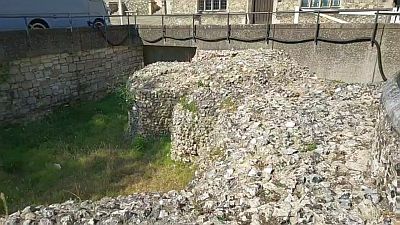 |
|
Henry III was born at Winchester Castle. That was the time when the legislation of the King always was in opposition to the demands of the Nobility, which eventually led to the Magna Charta in 1215.
|
|
There is still a stone in the ground, to remember that time and the importance of this document.
The people had been spoiled, because Henry II as well as Richard Lionheart were more interested in foreign politics, so they had had no time to govern England very strictly. When Richard's brother John (Jean Sans-Terre) became king, he tried to get more influence, which wasn't to the liking of the noblemen. So, the Magna Charta was a compromise and is today often seen as a first step to democracy.
|
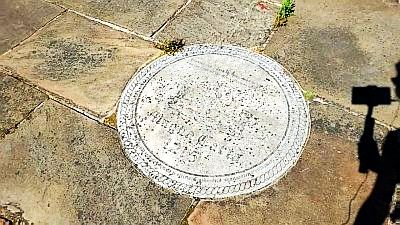 |
Back to Henry III. He decided to build the Great Hall, which is the only part of the castle, that is still standing. It was rebuilt rather often after its construction. On the image you can see some round holes near the top of the walls. Those were the original windows, keeping the place in a rather gloomy shape. Anyhow, the Great Hall was also used as a courtroom - and believe it, or not, that happened until the 1970's! In 1953 a Baron Montagu of Beaulieu was accused and convicted here ...
|
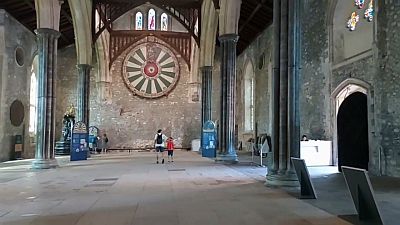 |
The round circle on the wall is actually a symbol for King Arthur's Round Table. With help of dendrology, counting the yearly rings in the wood, it has been determined that the table is from the year 1275.
Henry VIII had it repainted in the early 16th century. He put a portrait of himself as King Arthur on top of the table and all around at the edge of it the names of the Knights were painted. The table was used to impress foreign rulers. Charles V, Emperor of the Holy Roman Empire of German Nation is said to have visited the Great Hall. And he was the most important man of his time.
|
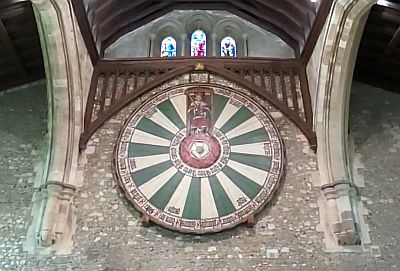 |
The wall at the side of the King's and the Queen's port are painted with names, beginning from the early 14th century. Those people were the representatives of Hampshire, throughout the years.
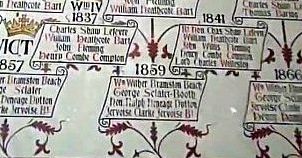
|
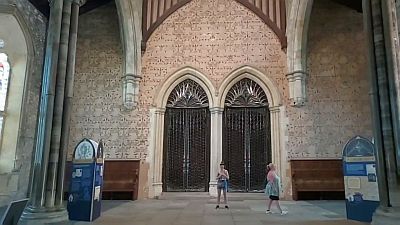 |
During later years there is a mark with an abbreviation of the name, whenever a new king or queen overtook the reign. So you can see to the very left "VICT" just before the year 1837, when Vitoria was proclaimed Queen.
Talking about her ... There is a statue of her as well in the Great Hall. It is said that she was not very fond of the idea of being carved into stone and refused to sit model. The sculptor was therefore forced to use his wife as model, which explains why the facial features not really are very authentic.
|
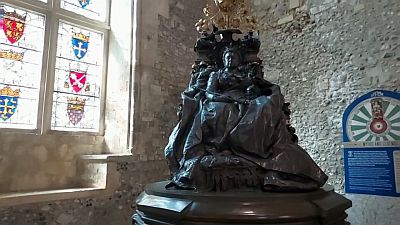 |
© Bernhard Kauntz, Västerås, 2022
Back to  or to the or to the  of of 
last update: 13.8.2022 by webmaster@werbeka.com
|

